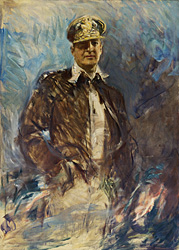

In September 1950, as George Marshall was beginning his new--and last--public duties as secretary of defense, his contemporary, General Douglas MacArthur (1880-1964), was successfully driving North Korea's Communist army back across the border, the Thirty-eighth Parallel. In command of United Nations forces in South Korea, MacArthur was capping an illustrious military career that spanned almost half a century.
Notwithstanding his accomplishments and immense popularity in the United States, MacArthur had been at odds with American foreign policy since before the start of World War II, when he was the commander in the Philippines. Specifically, he believed that America's frontiers were in Asia and that Communism should be stopped in that hemisphere at all costs. When his views became public in the spring of 1951, contrary to the adminstration's decision not to escalate the war in Korea north of the Thirty-eighth Parallel, President Truman was forced to relieve MacArthur of his command once and for all. As secretary of defense, Marshall accepted the decision, but cautioned the President about the inevitable political fallout. Within weeks, Marshall was to feel the repercussions in a slanderous attack from Wisconsin Senator Joseph McCarthy. Although McCarthy's allegations of duplicity were superfluous, they were bristling to Marshall on the eve of his final retirement from public service.
Douglas MacArthur
NEXT portrait
BACK to "George C. Marshall: Soldier of Peace"
Howard Chandler Christy (1873-1952)
Oil on canvas, 139.7 x 101.6 cm.
(55 x 40 in.), 1952
National Portrait Gallery,
Smithsonian Institution
Gift of Henry Ostrow